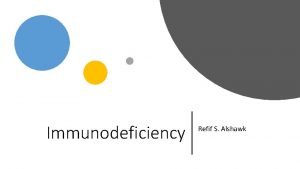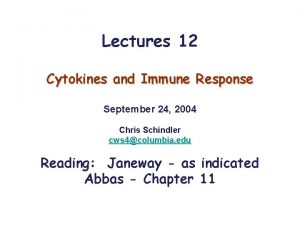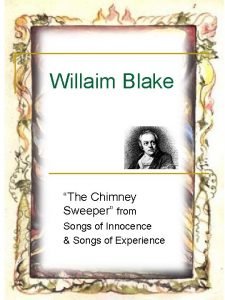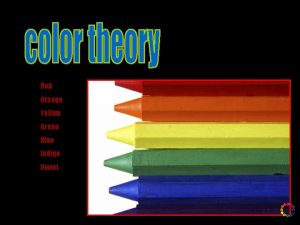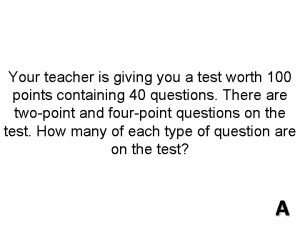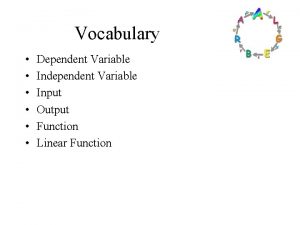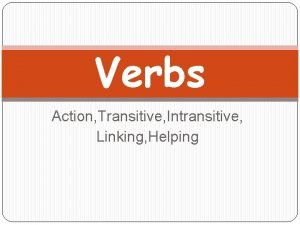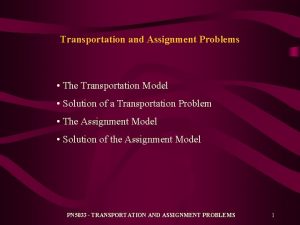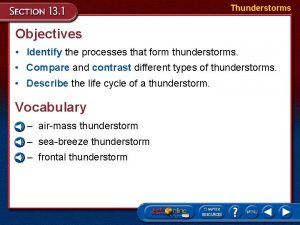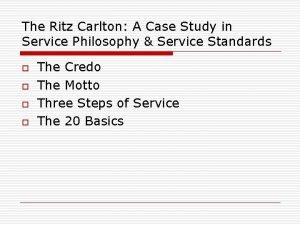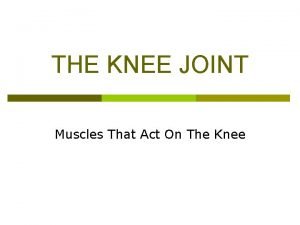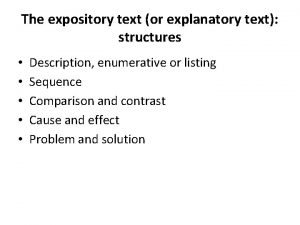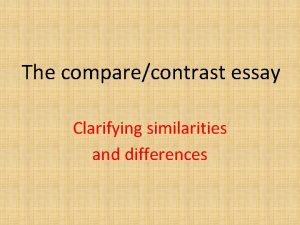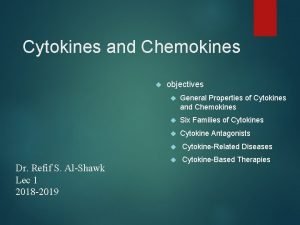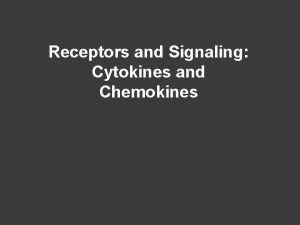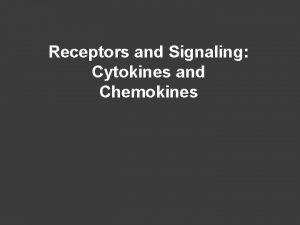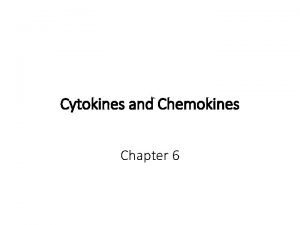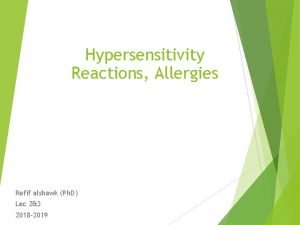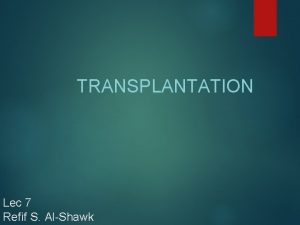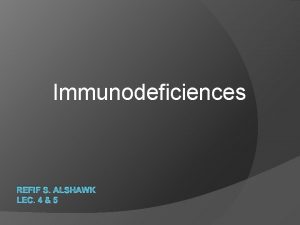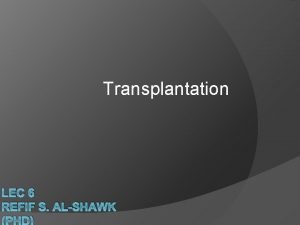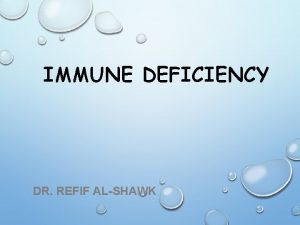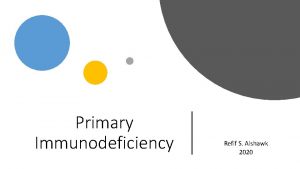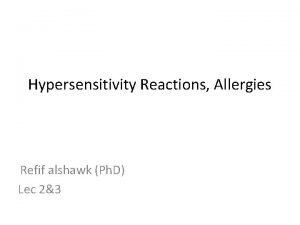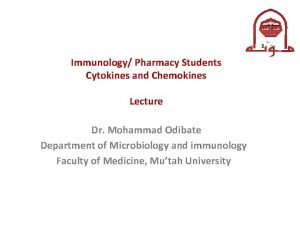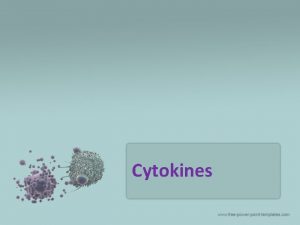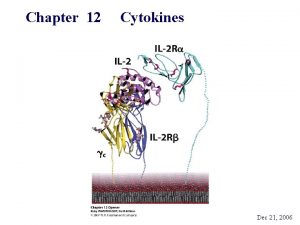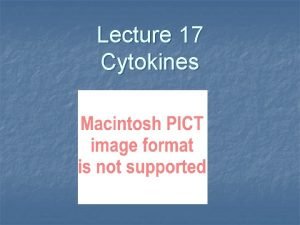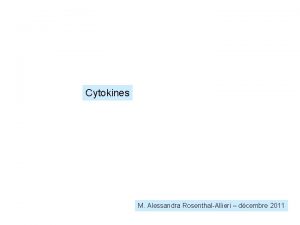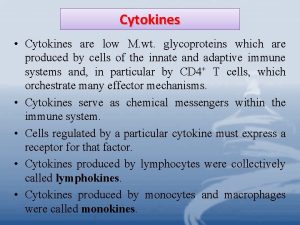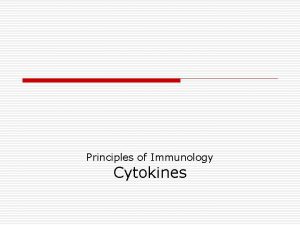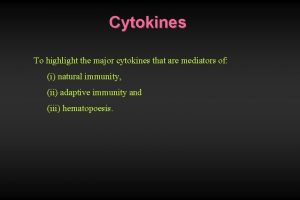CYTOKINES AND CHEMOKINES Refif S AlShawk Ph D































- Slides: 31

CYTOKINES AND CHEMOKINES Refif S. Al-Shawk (Ph. D) Lec 1 2017 -2018

Cytokines Low-molecular weight regulatory proteins or glycoproteins Secreted by WBC and various other cells Assist in regulating development of immune effector cells Referred to as Interleukins ○ IL-1 through IL-37 have been described

Chemokines subpopulation of cytokines that share the specific purpose of mobilizing immune cells from one organ, or from one part of an organ, to another. Subpopulation of cytokines Mobilize immune cells from one area to another Class of chemoattractants

General Properties of Cytokines and Chemokines 1. Cytokines Mediate the Activation, Proliferation, and Differentiation of Target Cells: Cytokines bind to specific receptors on the membranes of target cells, triggering signal transduction pathways that ultimately alter enzyme activity and gene expression. The susceptibility of a target cell to a particular cytokine is determined by the presence of specific membrane receptors and exhibit very high affinity for one another.

Cytokines regulate the intensity and duration of the immune response By stimulating or inhibiting the activation, proliferation, and/or differentiation of various cells, by regulating the secretion of other cytokines or of antibodies, or in some cases by actually inducing programmed cell death in the target cell cytokines can modulate the expression of various cell-surface receptors for chemokines, other cytokines, or even for themselves.

Cytokines exhibit the attributes of pleiotropy, redundancy, synergism, antagonism, and cascade induction

2. Cytokines Can Elicit and Support the Activation of Specific T-Cell Subpopulations; TH 1 cells secrete cytokines that ▬▬▬▬► promote the differentiation and activity of macrophages and cytotoxic Tcells, (intracellular bacteria are recognized and destroyed). How ? ? The cytokines IL-12 and interferon (IFN) γ induce TH 1 differentiation. TH 2 cells activate B cells to make antibodies, which ▬▬▬▬► neutralize and bind extracellular pathogens, ▬▬▬►making them susceptible to phagocytosis and complement-mediated lysis. How ? ? IL-4 and IL-5 support the generation of TH 2 cells. TH 17 cells promote the ▬▬▬▬► differentiation of activated macrophages and neutrophils, and support the inflammatory state; How ? ? their generation is induced by IL-17 and IL-23.


3. Cell Activation May Alter the Expression of Receptors and Adhesion Molecules What keeps cytokines from activating all T cells, for example, in a nonspecific fashion during the immune response? In order for a cell to respond to a signaling molecule, it must express receptors for that molecule.

For example, antigen stimulation of a T cell induces alterations in the T-cell surface expression of chemokine receptors. Reception of chemokine signals through these receptors therefore instructs only those cells that have previously been activated by antigen to migrate to nearby lymph nodes or to the spleen, ensures that stimulated cells migrate, and then remain in the location, and up-regulates the expression of the receptors for cytokines that provide proliferative signals, such as IL-2, and also for differentiative cytokines such as IL-4.

cytokines can be classifyed on the basis of the distance between the cell secreting the signaling ligand & the cell receiving that chemical signal : Of note, the T-cell interleukin IL-2 acts effectively in all three modes.

Cytokines belong to 6 families ○ Interleukin 1 (IL-1) ○ Hematopoietin family (Class I) ○ Interferon family (Class II) ○ Chemokine family ○ Tumor necrosis family ○ Interleukin 17 (IL-17) Based on structural studies All have molecular mass less than 30 k. Da All have similarities and few rarely act alone

Interleukin 1 (IL-1) Family typically secreted very early in the immune response ii. by dendritic cells and monocytes or macrophages. iii. IL-1 secretion is stimulated by recognition of viral, parasitic, or bacterial antigens by innate immune receptors. iv. IL-1 family members are generally proinflammatory, (what does that mean)? i.

they induce an increase in the capillary permeability at the site of cytokine secretion, amplification of the level of leukocyte migration into the infected tissues. IL-1 has systemic (whole body) effects and signals the liver to produce acute phase (CRP) and IL-6 These proteins further induce multiple protective effects, including the destruction of viral RNA generation of a systemic fever response (which helps to eliminate many temperature-sensitive bacterial strains). IL-18 stimulate production of the macrophage-activating cytokine IFN-γ by NK cells and T cells. innate immune response IL-1 also activates both T and B cells at the induction of the adaptive immune response. E. X. IL-1α and IL-1β , IL-18


Hematopoietin (Class I) Family ○ Called Class I because earliest to be structurally characterized (not first to be discovered) ○ Large family of small cytokine molecules with functional diversity ○ Not all involved in hematopoietic functions

Their cellular origins and target cells are as diverse as their ultimate functions, which range from; signaling the onset of T- and B-cell proliferation (e. g. , IL-2), to signaling the onset of B-cell differentiation to plasma cells and antibody secretion (e. g. , IL-6), to signaling the differentiation of a T helper cell along one particular differentiation pathway versus another (e. g. , IL-4 vs. IL-12) and finally, to initiating the differentiation of particular leukocyte lineages (e. g. , granulocyte monocyte-colony stimulating factors GM-CSF, GCSF). E. X. IL-2, IL-4, IL-5, IL-7, IL-9, IL-12, IL-15, IL-21 and GM-CSF

Interferon (Class II) First cytokines to be discovered ○ Type I - Secreted by not only macrophages and dendritic cells but also by virus infected cells: (1) Interferons α, and (2) interferon-β, ○ Type II – produced by activate T and NK cells , known as interferon-γ & cytokines include IL-10

Interferon-γ is used medically to bias the adaptive immune system toward a cytotoxic response in diseases such as leprosy and toxoplasmosis (intracellular pathogens), in which antibody responses are less effective. BY and inducing the activation of macrophages, with subsequent destruction of any intracellular pathogens and the differentiation of cytotoxic T cells. All three INFs (increase the expression of MHC complex proteins on the surface of cells, thus enhancing their antigenpresentation capabilities. )


Tumor Necrosis Family (TNF) ○ Can signal development, activation, or death of certain cells (homeostasis) ○ Which induce apoptosis, or programmed cell death, is a mechanism of cell death in which the cell dies from within and is fragmented into membranebound vesicles that can be rapidly phagocytosed by neighboring macrophages. Cytokines of the TNF Family ○ There are two members having the same name of the TNF family: TNF-α and TNF-β. Both of these are secreted as soluble proteins.

There are two members of the TNF family: TNF-α and TNF-β TNF-α is a proinflammatory cytokine, produced primarily by activated macrophages, and lymphocytes, in response to infection, or inflammation. TNF-β is produced by activated lymphocytes and can deliver a variety of signals. On binding to neutrophils, endothelial cells lead to increased expression of MHC and of adhesion molecules. Fas ligand (Fas. L), induces apoptosis.

Chemokines Direct the Migration of Leukocytes Through the Body; Are structurally related family of small cytokines that bind to cell-surface receptors and induce the movement of leukocytes up toward the chemokine source. This soluble factor-directed cell movement is known as chemotaxis, and molecules that can elicit such movement are referred to as chemoattractants located on the surfaces of endothelial cells, enables them to bind to the inner surfaces of blood vessels and directing leukocyte movement.

• CXCLgroup: attract neutrophils • CCL group: attract monocytes and macrophages (although not neutrophils) to the site of infection.


IL-17 Family (most recently described cytokines , proinflammatory cytokine cluster) interleukins 17 A, 17 B, 17 C, 17 D, and 17 F. Signaling through most members of this family culminates in the generation of inflammation. IL-17 released by activated T cells and stimulates the production of factors that signal a proinflammatory state, including IL-6, chemokines CXCL 8, and (G-CSF).

Cytokine Antagonists Number of proteins can inhibit cytokine activity ○ Can bind to receptor but fail to activate the cell, thus blocking the active cytokine from binding, OR ○ Can bind to cytokine, inhibiting its ability to bind to the

Cytokine Related Diseases Sever combined immunodeficiency (SCID) Genetic defects in cytokines, their receptors Defective receptor for IFN-γ Susceptible to mycobacterial infections

Cytokine Related Diseases Bacterial Septic Shock Certain bacteria: Staphyloccocus aureus, E. coli, Klebsiella pneumoniae …. . Symptoms: drop in blood pressure, fever, diarrhea, blood clotting Endotoxins (cell wall) bind TLRs on dendritic cells and macrophages leading them to produce ○ Over-produce IL-1β and TNF-α ○ Cytokine imbalance causes abnormal temp, abnormal respiration, capillary leakage, tissue injury, organ failure ○ Neutralization by monoclonal antibodies may help

Cytokine Related Diseases Bacterial Toxic Shock Microorganisms produce toxins that act as Superantigens ○ Bind simultaneously to Class II MHC and T cell receptor, activating T cell despite antigenic specificity , , induce extremely high levels of TNF-α and IL-1β Symptoms similar to sepsis

Cytokine-Based Therapies; Soluble TNF-α receptor and monoclonal antibodies against TNF-α ? ? have been used to treat rheumatoid arthritis and ankylosing spondylitis in more than a million patients. Which reduce proinflamatory cytokine cascades; help to alleviate pain, stiffness, and joint swelling; and promote healing and tissue repair. The recombinant form of IL-1 R receptor? ? has been shown to be relatively effective in the treatment of rheumatoid arthritis. Monoclonal antibodies directed against the IL-2 Receptors ? ? are also in clinical use for the prevention of transplantation rejection reactions
 Refifs
Refifs Examples of cytokines
Examples of cytokines Orange pink purple
Orange pink purple And because i am happy and dance and sing
And because i am happy and dance and sing West side story vs romeo and juliet worksheet
West side story vs romeo and juliet worksheet Younger shorter older old
Younger shorter older old How to write centavos
How to write centavos Red orange green blue indigo violet
Red orange green blue indigo violet One night a theater sold 548
One night a theater sold 548 Young and dyslexic igcse past paper
Young and dyslexic igcse past paper Albany movement
Albany movement West yorkshire health and care partnership
West yorkshire health and care partnership Draw and label a longitudinal wave
Draw and label a longitudinal wave Spring tide position
Spring tide position Dependent variable x or y
Dependent variable x or y Transitive and intransitive and linking verbs
Transitive and intransitive and linking verbs Meaning of life role
Meaning of life role Maintenance of records and reports
Maintenance of records and reports Prohibited route in transportation problem means
Prohibited route in transportation problem means Compare and contrast cold wave and wind chill factor
Compare and contrast cold wave and wind chill factor Vertical format of trading account
Vertical format of trading account Lesson preparation siop
Lesson preparation siop Tomorrow and tomorrow creeps in this petty pace
Tomorrow and tomorrow creeps in this petty pace Ritz carlton case study
Ritz carlton case study How were conglomerates and franchises alike and different
How were conglomerates and franchises alike and different Bicep femoris origin and insertion
Bicep femoris origin and insertion Gatsby chapter 3 questions
Gatsby chapter 3 questions The giver chapter 3 and 4 questions and answers
The giver chapter 3 and 4 questions and answers Explanatory vs expository
Explanatory vs expository Compare definition
Compare definition Compare and contrast analog and digital forecasts.
Compare and contrast analog and digital forecasts. The boy in the striped pyjamas film
The boy in the striped pyjamas film
